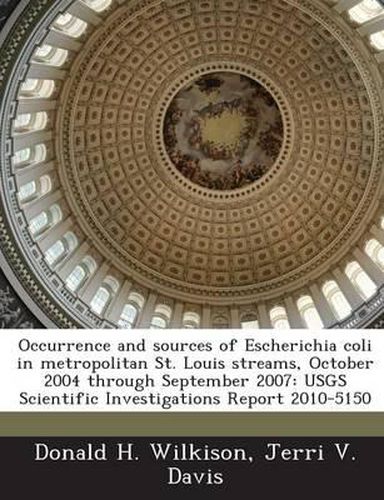Readings Newsletter
Become a Readings Member to make your shopping experience even easier.
Sign in or sign up for free!
You’re not far away from qualifying for FREE standard shipping within Australia
You’ve qualified for FREE standard shipping within Australia
The cart is loading…






The occurrence and sources of Escherichia coli (E. coli), one of several fecal indicator bacteria, in metropolitan St. Louis streams known to receive nonpoint source runoff, occasional discharges from combined and sanitary sewers, and treated wastewater effluent were investigated from October 2004 through September 2007. Three Missouri River sites, five Mississippi River sites, and six small basin tributary stream sites were sampled during base flow and storm events for the presence of E. coli and their sources. E. coli host-source determinations were conducted using local library based genotypic methods. Human fecal contamination in stream samples was additionally confirmed by the presence of Bacteroides thetaiotaomicron, an anaerobic, enteric bacterium with a high occurrence in, and specificity to, humans. Missouri River E. coli densities and loads during base flow were approximately 10 times greater than those in the Mississippi River above its confluence with the Missouri River. Although substantial amounts of E. coli originated from within the study area during base flow and storm events, considerable amounts of E. coli in the Missouri River, as well as in the middle Mississippi River sections downstream from its confluence with the Missouri River, originated in Missouri River reaches upstream from the study area. In lower Mississippi River reaches, bacteria contributions from the numerous combined and sanitary sewer overflows within the study area, as well as contributions from nonpoint source runoff, greatly increased instream E. coli densities. Although other urban factors cannot be discounted, average E. coli densities in streams were strongly correlated with the number of upstream combined and sanitary sewer overflow points, and the percentage of upstream impervious cover. Small basin sites with the greatest number of combined and sanitary sewer overflows (Maline Creek and the River des Peres) had larger E. coli densities, larger loads, and a greater percentage of E. coli attributable to humans than other small basin sites; however, even though small basin E. coli densities typically were much larger than in large river receiving streams, small basins contributed, on average, only a small part (a maximum of 16 percent) of the total E. coli load to larger rivers. On average, approximately one-third of E. coli in metropolitan St. Louis streams was identified as originating from humans. Another one-third of the E. coli was determined to have originated from unidentified sources; dogs and geese contributed lesser amounts, 10 and 20 percent, of the total instream bacteria. Sources of E. coli were largely independent of hydrologic conditions-an indication that sources remained relatively consistent with time.
$9.00 standard shipping within Australia
FREE standard shipping within Australia for orders over $100.00
Express & International shipping calculated at checkout
The occurrence and sources of Escherichia coli (E. coli), one of several fecal indicator bacteria, in metropolitan St. Louis streams known to receive nonpoint source runoff, occasional discharges from combined and sanitary sewers, and treated wastewater effluent were investigated from October 2004 through September 2007. Three Missouri River sites, five Mississippi River sites, and six small basin tributary stream sites were sampled during base flow and storm events for the presence of E. coli and their sources. E. coli host-source determinations were conducted using local library based genotypic methods. Human fecal contamination in stream samples was additionally confirmed by the presence of Bacteroides thetaiotaomicron, an anaerobic, enteric bacterium with a high occurrence in, and specificity to, humans. Missouri River E. coli densities and loads during base flow were approximately 10 times greater than those in the Mississippi River above its confluence with the Missouri River. Although substantial amounts of E. coli originated from within the study area during base flow and storm events, considerable amounts of E. coli in the Missouri River, as well as in the middle Mississippi River sections downstream from its confluence with the Missouri River, originated in Missouri River reaches upstream from the study area. In lower Mississippi River reaches, bacteria contributions from the numerous combined and sanitary sewer overflows within the study area, as well as contributions from nonpoint source runoff, greatly increased instream E. coli densities. Although other urban factors cannot be discounted, average E. coli densities in streams were strongly correlated with the number of upstream combined and sanitary sewer overflow points, and the percentage of upstream impervious cover. Small basin sites with the greatest number of combined and sanitary sewer overflows (Maline Creek and the River des Peres) had larger E. coli densities, larger loads, and a greater percentage of E. coli attributable to humans than other small basin sites; however, even though small basin E. coli densities typically were much larger than in large river receiving streams, small basins contributed, on average, only a small part (a maximum of 16 percent) of the total E. coli load to larger rivers. On average, approximately one-third of E. coli in metropolitan St. Louis streams was identified as originating from humans. Another one-third of the E. coli was determined to have originated from unidentified sources; dogs and geese contributed lesser amounts, 10 and 20 percent, of the total instream bacteria. Sources of E. coli were largely independent of hydrologic conditions-an indication that sources remained relatively consistent with time.